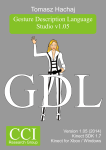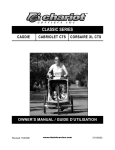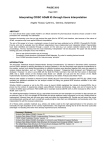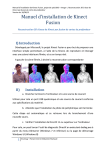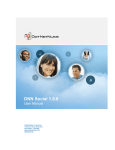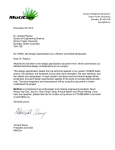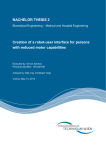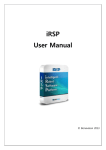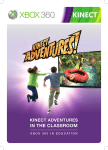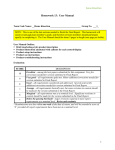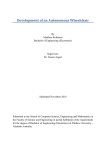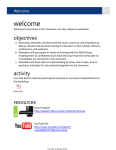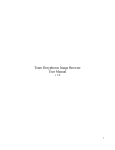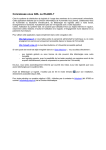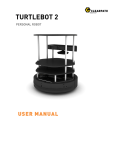Download Recording & recognition - Cryptography and Cognitive Informatics
Transcript
Author: Tomasz Hachaj, PhD Title: Kinect Almighty Tool 4 OpenNI User’s manual Version 1.0 (2013) CCI Research Group Affiliation: The Laboratory of Cryptography and Cognitive Informatics Pedagogical University of Krakow, 2 Podchorazych Ave, 30-084 Krakow, Poland [email protected] http://www.youtube.com/ccilaboratory http://www.cci.up.krakow.pl/ Kraków, 2013 1 Table of Contents INTRODUCTION ...................................................................................................................... 3 INSTALLATION ....................................................................................................................... 4 INTERFACE .............................................................................................................................. 5 “Main” window ...................................................................................................................... 5 “Rules” Window .................................................................................................................... 6 “Motor controller” window .................................................................................................... 6 “Recording & recognition” window ...................................................................................... 7 SOURCES, FUTURE PLANS, Kinect SDK ............................................................................. 9 REFERENCES AND USEFUL LINKS .................................................................................. 10 COPYRIGHT NOTICE ............................................................................................................... 11 2 INTRODUCTION This application demonstrates cooperation of GDL (Gesture Description Labguage) with Kinect controller and OpenNI. This document describes only this application. Manual for GDL can be found elswhere [1]. Kinect Almighty Tool 4 OpenNI is C# application (Windows Form framework) that gives an access to RGB and depth stream of Kinect for Xbox controller. It also enables user’s body segmentation, body joints tracking, body joints recording and gestures recognition (both real time – online and from recordings – off line). Body joints recordings are stored in text *.skl files that can be easily reused by other applications. The gestures recognition is made with GDL classifier that is described elsewhere [1], [2], [3], [4], [5], [6]. Kinect Almighty Tool 4 OpenNI requires third party software and libraries to be installed. The installation process is described in next paragraph. Before you decide to use the application in your project READ THE COPYRIGHT NOTICE (it is available at the end of this file). Long story short: this application is for scientific/educational purpose only. It cannot be used commercially. If the software is used in other software (non-commercial) products, installations or for research, it must always be cited as "GDL" and a reference to the: Tomasz Hachaj, Marek R. Ogiela, Rule-based approach to recognizing human body poses and gestures in real time, Multimedia Systems, September 2013, (DOI) 10.1007/s00530013-0332-2 has to be given. This form of citation does not require any permission. This software has been tested by us and lots of our students but IN NO EVENT SHALL THE COPYRIGHT HOLDER OR CONTRIBUTORS BE LIABLE FOR ANY DIRECT, INDIRECT, INCIDENTAL, SPECIAL, EXEMPLARY, OR CONSEQUENTIAL DAMAGES etc. This application is made for Kinect for Xbox NOT for Kinect for Windows device. For our knowledge you cannot use it with Kinect for Windows. If you have some questions about application itself, GDL methodology, licensing, scientific and commercial cooperation etc. feel free to contact my e-mail address [email protected]. Good luck and have fun! Tomasz Hachaj 3 INSTALLATION Software is 32-bit binary but runs also on 64-bit platform. To install the software you need to do following things under your Windows (XP or 7) system: a. Install Kinect drivers and tracking libraries (you can download it from our GDL project web page http://www.cci.up.krakow.pl/gdl/): i. nite-win32 ii. openni-win32 (v. 1.5 or higher, but it was not tested with 2.0 drivers!) iii. sensor-win32 iv. SensorKinect092-Bin-Win32 CAUTION: YOU CANNOT WORK SAME TIME ON TWO TYPES OF DRIVERS (FOR EXAMPLE OPENNI AND KINECT SDK) – ONLY ONE TYPE OF DRIVERS CAN BE INSTALLED ON YOUR WINDOWS SYSTEM – SEE [12]. b. .NET Framework 3.0 or higher (I should have this one already). c. Plug-in Kinect for XBox 360 controller to USB port of your computer (after the drivers will be automatically installed and green diode on Kinect will start blinking). d. You might need to copy OpenNiInstalationPath\OpenNI\Bin\OpenNI.net.dll into same directory as KatGDL4OpenNI.exe and replace the existing one but ONLY IF YOU ARE USING DIFFERENT INSTALLATION OF OPENNI THAN PROVIDED ON OUR WEB PAGE. Now you can run application KatGDL4OpenNI.exe :-) The start of application may take a while so be patient. If something gone wrong the application will display message with exception (most probably OpenNI driver exception). CAUTION: KINECT FOR XBOX HAS TO BE CONNECTED ALL THE TIME TO THE PC WHILE WORKING WITH THIS APPLICATION (EVEN IF YOU ARE WORKING “OFFLINE” WITH *.SKL RECORDINGS). The application was tested on Windows XP (32bit) and Windows 7 (64bit) with OpenNI 1.5. Remember that you cannot use Kinect SDK drivers and OpenNI drivers at the same time. If you previously installed Kinect SDK you have to uninstall it if you plan to use OpenNI. For instructions how to do this see [12]. The video http://www.youtube.com/watch?v=DRytxrwwIIk demonstrates how program should works after running. You can also visit CCI lab youtube profile: http://www.youtube.com/ccilaboratory or website http://www.cci.up.krakow.pl/ or http://www.cci.up.krakow.pl/gdl/ for more useful multimedia materials connected with Kinect Almighty Tool and GDL. 4 INTERFACE The application is consisted of several windows. “Main” window Main menu: Application->Show depth – if checked shows the depth stream data. The skeleton is drawn over depth and color stream. Application->Show depth->Show background – if checked shows depth stream data. If unchecked shows only skeleton if any. Application->Show Tracking - unused. Application->Show FPS – if checked shows the frames capture frequency. Application->Recording recognition – open “Recording & recognition” window in modal mode (the new window is over current one). Kinect->Motor – opens interface of “KinectMotorControl.exe” application. GDL->Load rules - loads GDL (*.gdl) file and parse rules. After this step the recognition is enabled. Some example GDL script files are stored in GDL subfolder. GDL->Display rules – shows parsed GDL file tree. GDL->Check confidence – if checked performs gestures recognition only if Neck, LeftShoulder, RightShoulder, Torso, LeftElbow, LeftHand, RightElbow, RightHand, LeftHip, and RightHip joints are tracked recognition (it is strongly connected to tracking divers behavior. It is recommended to have this option checked). GDL->Check first reliable user – if checked uses only first tracked user for recognition (it is strongly connected to tracking diver’s behavior. It is recommended to have this option checked. Look at OpenNI documentation for more details about user tracking). Screenshot makes screenshot of color and depth stream. The screens are stored in files screenshotDepthX.bmp and screenshotRGBX.bmp where X is not negative number. Program checks if the file with given name exits and never overwrite existing ones. Help->About The credits of the application, GDL engine and other modules. 5 “Rules” Window The window presents parsed tree of GDL script file. Each rule is root of different tree branch. “Motor controller” window CAUTION: THIS WINDOW USES THIRD PARTY SOFTWARE [9] Created by Anthony Smart | Copyright 2012 | All rights reserved. Track bar -> change angle of device (+/- 27 degrees horizontally). Apply -> apply changes of track bar. Reset position -> reset position of device to 0 degrees. 6 “Recording & recognition” window Main menu: GDL->Load rules - loads GDL file (*.gdl) and parse rules. After this step the recognition is enabled. Some example GDL script files are stored in GDL subfolder. GDL->Display rules – shows parsed GDL file tree. GDL->Use GDL – if checked the recognition of recording is performed. DTW –> unused. CAUTION: THE “RECORDING & RECOGNITION” WINDOW USES DIFFERENT INSTANCE OF GDL ENGINE THAN “MAIN WINDOW”. THE FILE GDL LOADED ON “MAIN WINDOW” IS NOT USED IN “RECORDING & RECOGNITION” AND VICE VERSA. “Record” button-> begins recording of gestures of single person in new file. The default name is SkeletonRecordX.skl (*.skl) where X is not negative number. Program checks if the file with given name exits and never overwrite existing ones. SKL file is created in same directory as EXE file. You do not have to save new recording (it is saved automatically). “Play” button -> plays the current recording. If “Use GDL” is enabled and GDL file is loaded the recognized rules are displayed over the video. There are two colors of displayed rules: magenta, and cyan. In cyan are all rules names that end with exclamation in magenta all others. Color of the rules has no meaning except visual. “Stop” button -> stops recording or playback. “Select file” button -> opens valid SKL file. “No name” button ;-) -> saves current opened recording. Progress bar -> shows the progress of video. “Range” button - removes range of frames from recording starting from actual cursor position (for example 120) to the frame with number inserted in second text box (for example 140). The remove range 120-140 will delete 21 frames. The modifications are not saved automatically in file (you have to click “No name” button to save it). “Begin” button -> removes range of frames from recording starting from beginning of video to actual cursor position. The modifications are not saved automatically in file (you have to click “No name” button to save it). 7 “End” button - removes range of frames from actual cursor position to the end of the video. The modifications are not saved automatically in file (you have to click “No name” button to save it). 8 SOURCES, FUTURE PLANS, Kinect SDK The sources of this application has been obfuscated to prevent (or make more difficult) reverse engineering of it. However we are planning to open the source of both Kinect Almighty Tool 4 OpenNI and GDL 4 OpenNI in few months so stay tuned ;-) We have also implementation of Kinect Almighty Tool and GDL for Kinect SDK drivers but because of our politics we cannot make it accessible at this moment as long as we are making scientific researches on them. However… we are planning to open the source of both Kinect Almighty Tool 4 KinectSDK and GDL 4 KinectSDK in few months so… stay tuned ;-) 9 REFERENCES AND USEFUL LINKS [1] [2] [3] [4] [5] [6] [7] [8] [9] [10] [11] [12] Tomasz Hachaj, Marek R. Ogiela, Rule-based approach to recognizing human body poses and gestures in real time, Multimedia Systems, September 2013, (DOI) 10.1007/s00530-013-0332-2 Tomasz Hachaj, Marek R. Ogiela, Semantic Description and Recognition of Human Body Poses and Movement Sequences with Gesture Description Language, Computer Applications for Bio-technology, Multimedia, and Ubiquitous City Communications in Computer and Information Science 2012, pp 1-8 Tomasz Hachaj, Marek R.Ogiela, Recognition of human body poses and gesture sequences with gesture description language, Journal of medical informatics and technology, vol 20/2012, ISSN 1642-6037, October 2012, pp. 129-135 Tomasz Hachaj, Marek R. Ogiela, Computer Karate Trainer in Tasks of Personal and Homeland Security Defense, A. Cuzzocrea et al. (Eds.): CD-ARES 2013 Workshops, LNCS 8128, pp. 430–441, 2013 Tomasz Hachaj, Marek R. Ogiela, Marcin Piekarczyk, Dependence of Kinect sensors number and position on gestures recognition with Gesture Description Language semantic classifier, Preprints of the Federated Conference on Computer Science and Information Systems (2013), pp. 575–579 Tomasz Hachaj, Marek R. Ogiela, Marcin Piekarczyk, Real-Time Recognition of Selected Karate Techniques Using GDL Approach, Image Processing and Communications Challenges 5, Advances in Intelligent Systems and Computing Volume 233, 2014, pp 99-106 CCI Lab homepage http://www.cci.up.krakow.pl/ CCI Lab youtube profile http://www.youtube.com/ccilaboratory Kinect Motor Control application website, which is used in our software (but is not necessary for it to function ;-) ) http://csmartonline.com/blog/2012/03/27/kinectmotor-control/ OpenNI framework website (I think they abandoned supporting Kinect after Kinect SDK was introduced by Microsoft…) http://www.openni.org/ Manual on installing OpenNI dirvers for Kinect http://www.codeproject.com/Articles/148251/How-to-Successfully-Install-Kinect-onWindows-Open Instructions on how to switch from Kinect SDK to OpenNI http://www.linkedin.com/groupItem?view=&gid=2642596&item=257772349&type= member&commentID=150516297&trk=hb_ntf_COMMENTED_ON_GROUP_DISC USSION_YOU_COMMENTED_ON#commentID_150516297 10 COPYRIGHT NOTICE Copyright (c) 2013 Tomasz Hachaj, The Laboratory of Cryptography and Cognitive Informatics [email protected] http://www.cci.up.krakow.pl/ http://www.cci.up.krakow.pl/gdl All rights reserved. Redistribution and use in source and binary forms, with or without modification, are permitted provided that the following conditions are met: Redistributions of source code must retain the above copyright notice, this list of conditions and the following disclaimer. Redistributions in binary form must reproduce the above copyright notice, this list of conditions and the following disclaimer in the documentation and/or other materials provided with the distribution. This software and its source code can be used only for scientific or/and educational purpose. It cannot be used commercially. Neither the name of the software nor the names of its contributors may be used to endorse or promote products derived from this software without specific prior written permission. If the software is used in other software products, installations or for research, it must always be cited as "GDL" and a reference to the: "Tomasz Hachaj, Marek R. Ogiela, Rule-based approach to recognizing human body poses and gestures in real time, Multimedia Systems, September 2013, (DOI) 10.1007/s00530-013-0332-2" has to be given. This form of citation does not require any permission. THIS SOFTWARE IS PROVIDED BY THE COPYRIGHT HOLDERS AND CONTRIBUTORS "AS IS" AND ANY EXPRESS OR IMPLIED WARRANTIES, INCLUDING, BUT NOT LIMITED TO, THE IMPLIED WARRANTIES OF MERCHANTABILITY AND FITNESS FOR A PARTICULAR PURPOSE ARE DISCLAIMED. IN NO EVENT SHALL THE COPYRIGHT HOLDER OR CONTRIBUTORS BE LIABLE FOR ANY DIRECT, INDIRECT, INCIDENTAL, SPECIAL, EXEMPLARY, OR CONSEQUENTIAL DAMAGES (INCLUDING, BUT NOT LIMITED TO, PROCUREMENT OF SUBSTITUTE GOODS OR SERVICES; LOSS OF USE, DATA, OR PROFITS; OR BUSINESS INTERRUPTION) HOWEVER CAUSED AND ON ANY THEORY OF LIABILITY, WHETHER IN CONTRACT, STRICT LIABILITY, OR TORT (INCLUDING NEGLIGENCE OR OTHERWISE) ARISING IN ANY WAY OUT OF THE USE OF THIS SOFTWARE, EVEN IF ADVISED OF THE POSSIBILITY OF SUCH DAMAGE. 11












